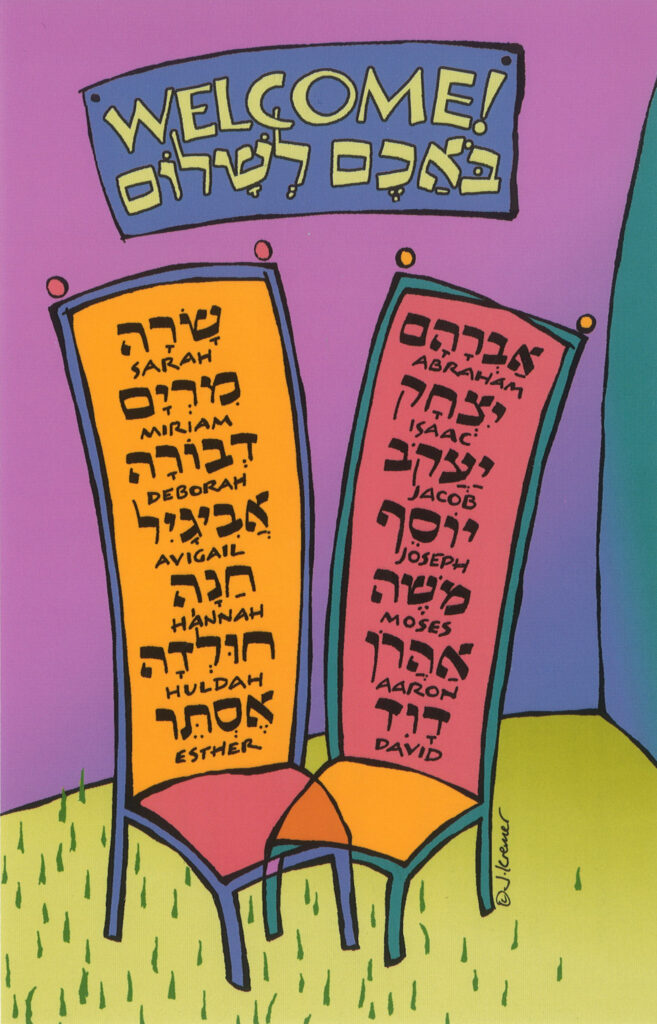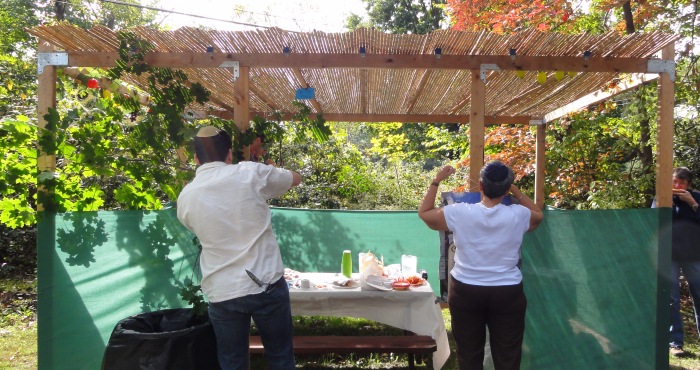An Invitation
After experiencing the hustle and bustle of the High Holidays, we are usually so exhausted physically and spiritually that the holiday of Sukkot gets left in the dust. So it is surprising that this week-long holiday is a time in which we are specifically commanded to be joyful. Additionally, the holiday concludes the time of spiritual rebirth and rediscovery associated with the fall season. We invite you to take the material on the following pages and create events through which your communities can memorably experience Sukkot.
The custom of ushpizot, symbolically inviting women guests into your sukkah (an innovative ritual based on the traditional custom of Ushpizin, Aramaic for guests), offers an ideal opportunity for communities to learn about women of the Bible and Jewish women throughout history in a meaningful, fun and creative way. Drawing on the mystical tradition of inviting biblical ancestors as guests into the sukkah, you can provide a context for studying women’s lives and accomplishments in an accessible and informal atmosphere. In addition, by introducing the rituals associated with Sukkot and using the themes of the holiday you can initiate communal discussion about creating welcoming and inclusive Jewish communities.
We know that your communities are committed to creating holiday and ritual programs that are fully inclusive of and responsive to Jewish women. In addition to helping Jewish women and girls find meaning in traditional Jewish rituals and celebrations, this type of program provides ways for you to integrate women’s voices into your activities. This sends an important message about the value of the voices and contributions of Jewish women, especially on Sukkot, the festival of booths.
Background
Welcoming Guests
“When you sit in the sukkah, ‘the shade of faithfulness,’ the Shechina spreads Her wings over you and… Abraham, five other righteous ones, and King David, make their dwelling with you…Thus you should rejoice with a shining countenance each and every day of the festival together with these guests who lodge with you…”(Zohar Emor, 103b).
One Sukkot custom that became popular in the Middle Ages, based on the mystical text known as the Zohar, was to invite “invisible” guests to the sukkah along with “visible” ones. Each night of Sukkot, a prayer would be recited asking a biblical figure to come and visit in the sukkah. The seven guests were usually Abraham, Isaac, Jacob, Moses, Aaron, Joseph, and David. Each of these ancient personalities represented a particular spiritual blessing, characteristic, or mystical aspect of God (sefirah). These figures were imagined to dine with their hosts, bringing their unique qualities into the sacred space of the sukkah.
While it is Jewish forefathers who have been publicly honored until very recently, Jewish women today are beginning to reclaim the strengths of their foremothers. One way to celebrate this journey during Sukkot is to invite biblical women into the sukkah along with their male counterparts. While there are different traditions about which women to invite, one mystical tradition, recorded by a medieval kabbalist named Menachem Azariah, tells us that we should invite the seven prophetesses listed in the Talmud as our seven female guests on Sukkot, paired with the seven male guests. These women, rich and varied in their stories and characters, are called Sarah, Miriam, Deborah, Hannah, Avigail, Huldah, and Esther. Each has a story within the Bible, and each has potential meaning for Jewish women who are searching for their foremothers.
For a description of each of the Biblical prophetesses and an explanation of their depiction of the Wall Poster scroll down to Artist’s Explanation of the Wall Chart.
How to Prepare Your Sukkah for Ushpizot
Traditions of welcoming ushpizin include the sharing of stories, the singing of songs and the study of traditional texts about the guests. A special welcoming prayer for the ushpizin can be found in some traditional prayer books. Some Sephardim (Jews of Spanish descent) place a special chair in the sukkah to welcome the guest of honor for the evening. The “chair of the ushpizin” remains empty throughout the meal. This custom is reminiscent of Elijah’s cup at the Passover seder and Elijah’s chair at a traditional circumcision. Some Sephardim actually make a plate of food for the biblical guest and set it down by the empty chair. The food is then sent to the poor with a note that says, “This is the share of the ushpizin.” Participants in ushpizot rituals may wish to set aside such a chair for one of their invisible female guests, or to collect tzedakah as part of their ritual.
Jewish artists over the centuries have created “ushpizin charts” to welcome each guest. These charts hang in the sukkah as instructional decorations. Traditional ushpizin charts usually feature images of male biblical characters surrounded by symbols of their mystical significance and their personal characteristics. Other diagrams include blessings and symbols for Sukkot, the signs of the zodiac, images of Israel, or the emblems of the twelve tribes. Ma’yan has designed a chart to help your community welcome the seven women prophets, our ushpizot. Created by artist Ellen Alt, the chart is rich in symbolism and integrates the seven species of fruit and grain indigenous to Israel with other more specific symbols related to each of the seven ushpizot. It also includes the adapted blessing for welcoming these women guests into the sukkah. You can use the chart to enhance your study of the seven women, as a basis for a brief, nightly, Sukkot ritual to welcome women guests or to simply decorate your sukkah with the lives of women. Contact Ma’yan for more information or additional copies of the ushpizot chart.
Acknowledgments:
Compiled by Erika Katske, formatted by Neely Harburger and produced and distributed by Ma’yan: the Jewish Women’s Project, a program of the JCC in Manhattan. Additions made by Rabbi Jill Hammer.
Thank you to Rabbi Carie Carter for her invaluable help in designing the program and to Rabbi Carol Levithan for her sources, suggestions and insight. Creating Your ushpizot Program.
Program Description
The Sukkot program is laid out in five sections that provide you with varied ideas and activities so that you can create a program for any kind of group. The event should take about two hours depending on the activities you choose. A more simplified program is one in which you hang the chart and learn together one Biblical woman, perform the ritual, and have a meal together. All of the following ideas are just suggestions— choose what is right for your community and then experiment with something different next Sukkot.
An outline of your program might look something like this:
1) Introduction, Explanations, and Meeting One Another (15 minutes)
This is a time when the assembled women are introduced to the program , including history and background on Sukkot and the tradition of inviting guests into the sukkah, and to each other. You might start with an opening song.
2) Learning and Creating (40-45 minutes)
Suggested options to mix and match:
Study: text study of biblical or historical women in chevruta (pairs) or as a group.
Use the ushpizot chart as a pretext to learn about the seven women. Teach about one or more of the women; divide your group into smaller groups, have each smaller group study one of the women using the material in the Ma’yan study packets and then report back; or invite a scholar or rabbi to come teach about one or more of the ideas. Here are some different courses you could take in focusing the study:
Art:1 handmade midrash (textual interpretation), ushpizot charts or other sukkah decorations.
As a complement to the chart, experiment with interpreting the text using art. Choose a verse or a few verses from the stories of the ushpizot chart. Develop some questions that challenge participants to imagine a particular scene, recreate a moment or describe the emotions the characters feel. Then ask them to depict their thoughts on paper using materials supplied; glue, colored paper, and markers or crayons.
Have them make their own ushpizot charts using a combination of images from magazines, hand-written verses, their own illustrations and any other decorations they choose. Have each group create a “chart” or poster, that describes and welcomes the ushpizot. They can also make life-size “visual guests” for the sukkah with the story and character of an ushpiza depicted within the trace of a person’s body. F or something that can lead into or bring closure to a discussion about issues of inclusion and exclusion in your community, try making welcome signs for the women you have chosen. For something a little simpler make sukkah decorations of fruit or new shapes created by the participants.
Movement: dance midrash and/or bibliodrama
Consider having each group prepare a short skit. These can be wordless, can use only words from the biblical text, or can include scripted dialogue. Provide instruments or other props for groups to use. The players may become Miriam by the shore of the Nile, Hagar cast out into the desert, the three angels who visit Sarah, or the stone on which Jacob slept and dreamed. Bibliodrama will help you to see the deep connections between the stories of the Bible and your own experience.
3) Discussing the Issues (10-20 minutes)
With its themes of permanence and impermanence, openness and welcoming, Sukkot is an ideal time to talk about issues of inclusion and exclusion in our communities. You may want to use the sukkah as a metaphor in your group discussion. Emphasize Sukkot as a time when the Jewish community goes outside its usual and familiar walls and when we open ourselves to the world around us through the sukkah’s openness.
Learning and discussing the stories of women, whether biblical, historical or contemporary, can also help us appreciate the importance of remaining aware of who we welcome into our communities and how we judge the value of individuals within our community. By extending the discussion to include some of these communal issues, you will not only give participants the opportunity to make direct connections between their own lives, the lives of the women around them, and the experiences of the women they have studied, but you will also provide a space for open dialogue among different members of your community.
Possible Topics:
– welcoming women into the sukkah/into Jewish tradition
– contemporary women/current issues around women and leadership
– sefirot, a mystical approach to the tradition of inviting guests
– issues of inclusion and exclusion in your community or in the wider Jewish community
4) Ritual (5-10 minutes)
A well-planned and facilitated ritual will meld all of the different elements of your program, giving participants a sense of the event’s purpose. The goal of the ritual is for participants, as a group, to welcome the women guests they have studied and discussed into the sukkah. Encourage everyone to contribute in some way during the ritual.
Invite participants to stand in a circle for a formal ritual to welcome the ushpizot. The ritual can begin with a niggun, song or an invocation using the names of the ushpizot and of other women that participants want to welcome into the sukkah.
Choose one or a few of the following options:
- Invite participants to invoke the qualities and character traits of the ushpizot in addition to their names. For example, you could welcome peace, understanding, and appreciation of diversity into your sukkah.
- Ask participants to call out names of ushpizot and other women who have been sources of shelter or protection for the Jewish community and/or individuals.
- Ask participants to call out the names of groups or individuals who have been wanderers in search of a resting-place (i.e. the ushpizot, single mothers, Jews by choice, gays and lesbians). Offer them your sukkah and your community as a welcoming, restful home.
- Ask participants to share who and what they want to welcome into their own lives during the coming year (rest, self-love, etc).
- Recite the following invocation, adapted from the traditional Aramaic blessing formally welcoming the guests to join the group in the sukkah.2
This can be spoken or chanted together:
Enter holy guests from on high; enter hallowed mothers of our people, sisters, wise women and prophets. Take your place with us under the protecting canopy of the Shechina, in this sukkah of peace. Enter Sarah, Miriam, Hannah, Devorah, Avigail, Huldah, and Esther.
Enter ______, ______, _______…. (INVITE PARTICIPANTS). Enter, all those whose names we don’t even know, because you have been lost to us.
We are ready to fulfill the ancient words which call us still:, “You shall dwell in booths seven days, all that are Israelite shall dwell in booths, in order that your generations may know that I made the children of Israel dwell in booths when I brought them out of the land of Egypt, (the land of Narrow Places).”
As we welcome you today into our sukkah, may we soon welcome into our communities all women, who like you, have voices and visions and leadership much needed in our communities.
Take your place, take your place, guests from on high. Take your place, take your place, hallowed guests. May we all join you in taking our own places and in making places for others under the protection of Shechina.
4) Social Time (15-30 minutes)
– decorating the sukkah
– food and schmooze
Taking Action
A full discussion could lead your group to decide that it wants to take action around some of the issues raised. As the facilitator, you might want to help your group decide what that action might look like. You may all commit to writing a letter to a leader of your community about a particular issue. You may decide to plan a follow-up event or social action project. Don’t feel pressured to decide on the spot. If time is running short, find a way of harnessing the energy generated by the discussion. For example, collect names of people who are interested in talking further or form a small committee who can meet at a later date, and then move on to the ritual.
Incorporating Tzedakah into Your Program
As the sukkah can be seen as a metaphor for our community, welcoming the ushpizot into the sukkah can lead directly to a discussion about our responsibility to support women and girls in our community and in the world. Think with your group about ways that you can symbolize welcoming through tzedakah those who might be excluded from your community. Choose one of the following ways to add a tzedakah element to your event:
- Collect canned food for a women’s shelter or food pantry. Be sure to note in your invitations or other publicity that you will be collecting donations.
- Choose one organization to be the focus for the event’s tzedakah; donate proceeds from the event, or collect donations from participants; have a representative from that organization or program speak briefly about her work and the women and girls whom the organization benefits.
- Ask participants to sign up to volunteer a day of service with your group at a local service project that works with women or girls.
- Invite Jewish women from a local retirement community to participate in your event.
Artist’s Explanation of the Wall Chart
The women prophets of the Bible are here depicted as blocks of a protecting wall held together with melted Shabbat candles mixed with gold powder. Each woman carries a piece of her own story which is also part of our people’s story. The poster also includes all seven species, a symbol of the fruitfulness of Israel.
Sarah (earlier known in the Bible as Sarai) is Abraham’s wife, with whom she journeyed from Ur to Canaan to Egypt and back. Sarah’s barrenness jeopardizes the covenant God made with her and Abraham to make their progeny numerous and give them the land of Israel. When God promises Sarah that in her old age she will have a son, she laughs at the prospect. Later, her son, Isaac, is named in tribute to her laughter (Isaac means laughter). In the chart, Sarah is the barren desert of Israel under an immense sky filled with divine light. She is also fertility: the ancient symbol of the fish, and the modern microscopic image of sperm and egg.
Miriam first appears in the Torah as the unnamed sister of baby Moses. She saves him from drowning by convincing the daughter of Pharaoh to adopt him and raise him as her own son. In her next appearance in the narrative, she is identified as “Miriam the Prophet” who leads the Israelite women in song and dance after the crossing of the Sea of Reeds. Miriam is Egypt and Exodus: papyrus, wheat for matzah, dancing letters and music notes for Miriam’s dance and timbrel playing.
Deborah is the Bible’s only female judge and the only judge to be called a prophet. As the ruler of the Israelites, she plays a critical role in the Israelites’ victory over the Caananites led by King Jabin and his general, Sisera. Deborah is judgment. We see the palm tree under which she sat and weighed different points of view here symbolized as colored dots on both sides of the divided block above the tree.
Hannah is one of the two wives of Elkanah. In despair over being childless, Hannah goes with her husband to the temple at Shiloh and makes a private plea to become pregnant with a son. God hears Hannah’s words, and she becomes pregnant and gives birth to a son, Samuel. In her joy, Hannah sings a triumphant song that proclaims her success over her adversaries and the ultimate power of God. Hannah is a red wildflower who has endured despite adverse conditions; the Calanit flower is also known as “tears of Hannah.” The flower is veiled to show Hannah’s quiet prayer, which flows in a rhythm of blues.
Avigail’s story begins with a description of the wealth of Nabal, her husband. The soon-to-be King David, traveling in the area, asks Nabal for hospitality. Nabal refuses, and David, angered, prepares to attack him. Avigail brings David gifts of food and drink and asks him to spare her husband. On the chart, Avigail is splendor and abundance. Water is available, roots are anchored to the ground, barley grows, figs, grapes and flowers flourish.
Huldah is a prophet who validates a scroll found in the temple during the time of King Josiah. Josiah sends his ministers to ask Huldah if the scroll is authentic. It appears from this scene that prophecy was a role that was open to women in biblical times. Huldah’s prophetic statements have a historic impact, as they legitimize the text of the Bible. On the chart Huldah has the power of connection. She is technically wired, she harnesses electricity and builds bridges. She is versatile like olives and her mind is like a well-oiled machine.
Esther is introduced as one of the young virgins taken into the Persian King Ahasuerus’s harem as possible replacements for Vashti, the king’s banished wife. Esther is chosen to become queen but does not make her Jewish identity known to the king or his court until it becomes necessary for her to reveal herself to save her people. Esther, the queen, surrounded by grandeur, is a pomegranate. At her head is a crown, the shape of a Jewish star.
————————-













